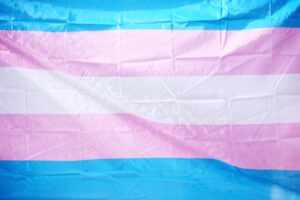Transgender Day of Visibility
Each year on March 31st, the world celebrates Transgender Day of Visibility (TDOV). This day is celebrated to raise awareness about transgender people. The day is utilized to acknowledge the contributions of trans individuals. It also aims at educating people on the poverty, discrimination, and violence that the transgender community is subjected to.
TDOV was established in 2010 by a trans advocate named Rachel Crandall. Crandall created TDOV in response to the media stories focusing on transgender people and violence. The motivation behind the day was to switch the focus to celebrating the lives of transgender people. In addition, the day was created to acknowledging that because of discrimination, not all trans people can or want to be visible1.
Relevant Vocabulary
A majority of people who have biological parts that are considered male, also consider themselves to identify as male, and vice versa with females. We refer to these people as cisgender (cis). For example, a person who is born with biological parts, such as a penis, and also identifies themselves as a male, would be considered cis.
Transgender refers to an individual who has a gender identity that does not match the sex they were given at birth. For example, a person may have been born with biological parts, such as a vulva, vagina, and uterus, however, they identify as male2. Lesbian, Gay, Bisexual, Transgender, and Queer (LGBTQ+) refers to those who identify in any of these groups, as well as those who identify as questioning, non-binary, etc. Questioning refers to individuals who are uncertain of their sexuality, while non-binary refers to those who do not identify as female or male specifically.
Importance of TDOV
Over the course of history, we have seen wonderful progress with inclusion in film and TV. Casting has increased transgender presence, as well as developed more accurate portrayals of transgender people’s lived experiences. As of TDOV 2022, there were 42 recurring transgender characters appearing on broadcast, streaming, and cable. While this is a definite step in the right direction, we must also acknowledge that 42 characters cannot even come close to representing the full diversity within the trans community.
In 2023 so far, over 300 anti-LGBTQ+ bills have been filed. Over half of these are specifically targeting trans people, oftentimes trans youth. 2023 follows 2021 as the most anti-LGBTQ+ legislative session in history. It’s imperative that we call out politicians, networks, news stations, and other sources of entertainment and media who are misrepresenting the transgender community3.
As a way to participate in TDOV, there are a variety of things that allies can do in solidarity with LGBTQ+ inclusion. This list includes: educating yourself, being mindful of overstepping, being cognizant of stereotypes, sharing and asking others’ pronouns, calling elected officials and voting, supporting LGBTQ+ positive organizations, and being aware of policies in your workplace.

10 Simple Ways to Support the Transgender Community
1. Educating Yourself
One of the simplest and most important ways to be a positive ally to the trans community is to educate yourself. If you know trans people, asking questions and having conversations about their experiences can be a beneficial way to understand what being trans means to them. However, it is not a trans person’s job to educate cis-people on these topics. If you want to be a good ally, do your research. Read books, watch videos, and keep up with legislation, in order to understand the facts, rather than believing stereotypes or misinformation4. This also means keeping up-to-date on current language and terminology used within and with regards to the transgender community.
2. Be Mindful of Overstepping
While it is encouraged to get to know trans people and understand their experiences, it is also important to be mindful of what you ask. Just as with a cis person, there are appropriate and inappropriate questions to ask others. Based on the person, your relationship with them, and their comfort level, there are always subjects to be cautious of, in order to be respectful of others and their own boundaries. Here are some topics that many trans people feel uncomfortable talking about, which you may want to avoid unless they bring it up or offer this information willingly:
- Birth Name
- Photographs from prior to the transition
- Hormones they may or may not be taking
- Surgeries they have or have not had, and reasons related to these choices
- Questions related to their sexual relationships
3. One Size DOES NOT Fit All
Just as is with cis people, not all trans people are the same. Cisgender is a fairly broad label that only refers to one aspect of a person’s existence. Likewise, trans is only one part of a person’s identity. Some trans people choose to medically transition, while others do not. While parts of the trans community choose to legally change their names and identifications, some do not. There are individuals who identify as trans and change their appearance, such as their clothing, hair, etc., while other trans people do not. It is important to note that some members of the trans community may have a desire to do these things, yet cannot due to finances or safety concerns. Regardless of the reasons behind each aspect, someone is not ‘more’ or ‘less’ trans based on the changes they have or have not made to transition5.
4. Ask & Tell Others Pronouns
Another simple way to be a strong ally to the LGBTQ+ community is to utilize your own pronouns regularly. Many people have done this by including their pronouns on professional websites, such as Linked In, stating their pronouns in their signature on their e-mail, and introducing themselves with their pronouns. For example, ‘Hi, my name is Tom and I go by they/them pronouns’.
Some people state that they do not like using pronouns because they do not want to offend someone by asking what their pronouns are. However, if you are talking with someone and the person’s pronouns have not come up naturally in conversation, it is more than okay to ask them. A way to do this respectfully, would be to first state your own pronouns and then ask theirs. For example, ‘My name is Tom and I go by they/them pronouns, what about you?’.
Another concern is if you use the wrong pronouns. However, if you recognize you used the wrong pronouns, simply apologize and move on. Making a huge ordeal out of it can draw unwanted attention to the person and be uncomfortable for all involved6.
5. Talk about LGBTQ+ People and Educate Others
As we see society becoming more open to and accepting of LGBTQ+ people, it is imperative that we keep these conversations going. Educate your loved ones about the differences between sex and gender, as well as how this is an important distinction for those who do not identify as cisgender. The more we have these conversations, the more we open up the idea of acceptance that other’s may not identify as we do, and that is more than okay! If you feel a bit lost on how to have these conversations, use books or videos, such as those found on The Human Rights Campaign’s Youtube Channel. These videos can help to make sure you are productive and informed during these conversations7.
6. Use Inclusive Language
Imagine if when others addressed a crowd they used terminology that specifically made you feel excluded. For instance, let’s say that you identify as a female and a speaker addressed the room by saying ‘Welcome Gentlemen’, you may feel unwelcome and out of place. There are simple, yet effective, ways for each of us to be more inclusive in our speaking that can help all to feel welcomed. If you are addressing a group of people, you could say ‘welcome colleagues’ or ‘welcome attendees’, rather than ‘ladies and gentlemen’. This takes the assumption out of the phrase and helps all to feel included. More examples of everyday changes we can make would be to use firefighter, instead of fireman, postal worker, rather than mailman, waitstaff rather than waitress, and police officer, rather than policemen8.
7. Avoid Microaggressions
Microaggressions are statements that can cause emotional distress to another person, even if the individual saying them thought they were being supportive. With regards to transgender people specifically, microaggressions tend to reduce a trans person to a few body parts and give them a value based on their ability to conform to cisgender beauty standards. Some examples of microaggressions towards the trans community include:
- Did you have surgery yet?
- I would never have known you were trans, you look cis!
- You are way too pretty to have been a man!
- I could tell you were trans because of your… [voice, hands, jawline, etc.]
- If you were going to date girls, why didn’t you just stay a man?
- How do you have sex?
Part of being a good ally is to not only recognize when you, yourself, are making these unintentional comments, but to also call others out when they are. Whether someone makes a ‘joke’, a dismissive comment, or is intentionally misgendering someone, it is your job as an ally to stand up to these microaggressions. Remember that if you speak up, it can help others to feel confident in speaking out against these injustices as well9.
8. Calling Elected Officials and Voting
As stated previously, many laws are being proposed that actively harm the LGBTQ+ community, and many are specifically targeting transgender people. While we cannot stop these from being proposed, we can make a difference by making sure they do not get enacted. We can each contribute to these causes by calling elected officials, writing Op Eds, testifying at hearings, collecting signatures for petitions/ballot initiatives, and voting. These are all important ways to continue the movement in the right direction10.
9. Support Organizations
Many services that cis people take for granted are inaccessible or unsafe for trans people. Mental health services, suicide-prevention services, low-income housing/homeless shelters, social services, public transportation, and public safety are all areas that can be difficult, or sometimes even impossible, for trans people to access. Researching organizations that support the transgender community and giving them your support can make a huge difference. Whether it is utilizing their services yourself, donating, or volunteering your time, showing your support to those who support trans people can make a major impact11.
10. Check the Policies in your Workplace
Checking the policies at work can ensure that your workplace is an inclusive environment for all regardless of gender identity or expression. If you find that your workplace needs to update policies, make recommendations to your Human Resources team to bring policies up to date. Things to look out for:
- Dress Codes (do they reinforce gender stereotypes, or cause stress to nonbinary people? Ex: requirements for wearing dresses/skirts/etc.)
- Healthcare Offerings/Policies (do they offer transgender healthcare, mental health services, are exclusions written in?)
- Does your nondiscrimination policy include protections for transgender people and specify ramifications for those who do not adhere?
- Does your workplace offer access to private or gender-neutral restrooms?12
- Do you have Transgender-inclusive trainings, which teach staff how to treat trans people with respect, professionalism, and courtesy?
Seeking Support for the Transgender Community
If you are looking for a therapist to discuss concerns regarding LGBTQ2+ questions or thoughts, or to discuss your experience as a member of the LGBTQ2+ community, our therapists through Online-Therapy.com provide Cognitive Behavioral Therapy (CBT)
Gender identity can be an important topic to discuss. We have a variety of therapists who would love to help you with mental health concerns. Our platform offers a complete online therapy toolbox for individuals and couples! Our site has multiple options, which involve time with a personal therapist who can support you throughout your journey. If this is something you have an interest in, we would love to hear from you.




Leave A Comment